Bulk Modification of Sonogel–Carbon with Polyaniline: A Suitable Redox Mediator for Chlorophenols Detection
Abstract
1. Introduction
2. Materials and Methods
2.1. Reagents
2.2. Instrumentation
2.3. Synthesis of Polyaniline Powder and Graphite/Polyaniline Composites
2.4. Synthesis and Elaboration of Sonogel–Carbon–Polyaniline Electrodes
2.5. Measuring Procedure
2.6. Real Sample Analysis
3. Results
3.1. Effect of the Modifier on the Mechanical/Electrochemical Features of the Conducting Composite
3.2. Electrochemical Characterization
3.2.1. Characterization of the Redox Process of Polyaniline
3.2.2. Electrochemical Behavior Using Ferrocyanide System
3.3. Structural Characterization by Fourier Transformed Infrared Spectroscopy (FTIR)
3.4. Electrochemical Assessment of PCMC Using SNG–C-Modified Material
3.4.1. Preliminary Electrochemical Detection
3.4.2. Effect of pH on PCMC Electro-Oxidation
3.4.3. Effect of PCMC Concentration
3.4.4. Reproducibility and Repeatability Studies
3.4.5. Effect of Salts and Phenols on PCMC Detection
3.4.6. Spiked Water Analysis
3.5. Electrochemical Detection of Other Chlorophenols of Interest
4. Conclusions
Supplementary Materials
Author Contributions
Funding
Institutional Review Board Statement
Informed Consent Statement
Data Availability Statement
Acknowledgments
Conflicts of Interest
References
- Xiang, H.; Deng, N.; Zhao, H.; Wang, X.; Wei, L.; Wang, M.; Cheng, B.; Kang, W. A Review on Electronically Conducting Polymers for Lithium-Sulfur Battery and Lithium-Selenium Battery: Progress and Prospects. J. Energy Chem. 2021, 58, 523–556. [Google Scholar] [CrossRef]
- Simotwo, S.K.; Kalra, V. Polyaniline-Based Electrodes: Recent Application in Supercapacitors and Next Generation Rechargeable Batteries. Curr. Opin. Chem. Eng. 2016, 13, 150–160. [Google Scholar] [CrossRef]
- Chen, X.; Guo, B.; Hu, P.; Wang, Y. A Non-Enzymatic Hydrogen Peroxide Sensor Based on Gold Nanoparticles/Carbon Nanotube/Self-Doped Polyaniline Hollow Spheres. Electroanalysis 2014, 26, 1513–1521. [Google Scholar] [CrossRef]
- Patil, D.S.; Pawar, S.A.; Patil, S.K.; Salavi, P.P.; Kolekar, S.S.; Devan, R.S.; Ma, Y.R.; Kim, J.H.; Shin, J.C.; Patil, P.S. Electrochemical Performance of Potentiodynamically Deposited Polyaniline Electrodes in Ionic Liquid. J. Alloys Compd. 2015, 646, 1089–1095. [Google Scholar] [CrossRef]
- Shen, K.; Ran, F.; Zhang, X.; Liu, C.; Wang, N.; Niu, X.; Liu, Y.; Zhang, D.; Kong, L.; Kang, L.; et al. Supercapacitor Electrodes Based on Nano-Polyaniline Deposited on Hollow Carbon Spheres Derived from Cross-Linked Co-Polymers. Synth. Met. 2015, 209, 369–376. [Google Scholar] [CrossRef]
- Andreev, V.N. Effect of Solution Acidity on the Electrochemical Behavior of Nafion–Polyaniline Films. Russ. J. Electrochem. 2005, 41, 200–202. [Google Scholar] [CrossRef]
- Sanchis, C.; Ghanem, M.A.; Salavagione, H.J.; Morallón, E.; Bartlett, P.N. The Oxidation of Ascorbate at Copolymeric Sulfonated Poly(aniline) Coated on Glassy Carbon Electrodes. Bioelectrochemistry 2011, 80, 105–113. [Google Scholar] [CrossRef]
- Gicevicius, M.; Kucinski, J.; Ramanaviciene, A.; Ramanavicius, A. Tuning the Optical pH Sensing Properties of Polyaniline-Based Layer by Electrochemical Copolymerization of Aniline with O-Phenylenediamine. Dye. Pigment. 2019, 170, 107457. [Google Scholar] [CrossRef]
- Zhao, X.; Bai, W.; Yan, Y.; Wang, Y.; Zhang, J. Core-Shell Self-Doped Polyaniline Coated Metal-Organic-Framework (SPAN@UIO-66-NH2) Screen Printed Electrochemical Sensor for Cd2+ Ions. J. Electrochem. Soc. 2019, 166, B873. [Google Scholar] [CrossRef]
- Dkhili, S.; López-Bernabeu, S.; Huerta, F.; Montilla, F.; Besbes-Hentati, S.; Morallón, E. A Self-Doped Polyaniline Derivative Obtained by Electrochemical Copolymerization of Aminoterephthalic Acid and Aniline. Synth. Met. 2018, 245, 61–66. [Google Scholar] [CrossRef]
- Tsakova, V.; Seeber, R. Conducting Polymers in Electrochemical Sensing: Factors Influencing the Electroanalytical Signal. Anal. Bioanal. Chem. 2016, 408, 7231–7241. [Google Scholar] [CrossRef] [PubMed]
- Weng, C.J.; Chen, Y.L.; Chien, C.M.; Hsu, S.C.; Jhuo, Y.S.; Yeh, J.M.; Dai, C.F. Preparation of Gold Decorated SiO2@polyaniline Core-Shell Microspheres and Application as a Sensor for Ascorbic Acid. Electrochim. Acta 2013, 95, 162–169. [Google Scholar] [CrossRef]
- Rajpurohit, A.S.; Punde, N.S.; Rawool, C.R.; Srivastava, A.K. Application of Carbon Paste Electrode Modified with Carbon Nanofibres/Polyaniline/Platinum Nanoparticles as an Electrochemical Sensor for the Determination of Bezafibrate. Electroanalysis 2018, 30, 571–582. [Google Scholar] [CrossRef]
- Afzali, M.; Jahromi, Z.; Nekooie, R. Sensitive Voltammetric Method for the Determination of Naproxen at the Surface of Carbon Nanofiber/gold/polyaniline Nanocomposite Modified Carbon Ionic Liquid Electrode. Microchem. J. 2019, 145, 373–379. [Google Scholar] [CrossRef]
- Kalambate, P.K.; Rawool, C.R.; Srivastava, A.K. Fabrication of Graphene Nanosheet–multiwalled Carbon Nanotube–polyaniline Modified Carbon Paste Electrode for the Simultaneous Electrochemical Determination of Terbutaline Sulphate and Guaifenesin. New J. Chem. 2017, 41, 7061–7072. [Google Scholar] [CrossRef]
- Afzali, M.; Mostafavi, A.; Shamspur, T. Square Wave Voltammetric Determination of Anticancer Drug Flutamide Using Carbon Paste Electrode Modified by CuO/GO/PANI Nanocomposite. Arab. J. Chem. 2020, 13, 3255–3265. [Google Scholar] [CrossRef]
- Gautam, V.; Singh, K.P.; Yadav, V.L. Polyaniline/MWCNTs/starch Modified Carbon Paste Electrode for Non-Enzymatic Detection of Cholesterol: Application to Real Sample (cow Milk). Anal. Bioanal. Chem. 2018, 410, 2173–2181. [Google Scholar] [CrossRef]
- Patel, B.R.; Noroozifar, M.; Kerman, K. Prussian Blue-Doped Nanosized Polyaniline for Electrochemical Detection of Benzenediol Isomers. Anal. Bioanal. Chem. 2020, 412, 1769–1784. [Google Scholar] [CrossRef]
- Bellido-Milla, D.; Cubillana-Aguilera, L.M.; El Kaoutit, M.; Hernandez-Artiga, M.P.; Hidalgo-Hidalgo De Cisneros, J.L.; Naranjo-Rodríguez, I.; Palacios-Santander, J.M. Recent Advances in Graphite Powder-Based Electrodes. Anal. Bioanal. Chem. 2013, 405, 3525–3539. [Google Scholar] [CrossRef]
- Izaoumen, N.; Cubillana-Aguilera, L.M.; Naranjo-Rodríguez, I.; Hidalgo-Hidalgo de Cisneros, J.L.; Bouchta, D.; Temsamani, K.R.; Palacios-Santander, J.M. β-Sonogel-Carbon Electrodes: A New Alternative for the Electrochemical Determination of Catecholamines. Talanta 2009, 78, 370–376. [Google Scholar] [CrossRef]
- Cubillana-Aguilera, L.M.; Palacios-Santander, J.M.; Estevez-Hernandez, O.L.; Naranjo-Rodriguez, I.; Hidalgo-Hidalgo De Cisneros, J.L. 1-Furoylthiourea-Sonogel-Carbon Electrodes: Structural and Electrochemical Characterization. Talanta 2010, 82, 129–136. [Google Scholar] [CrossRef]
- Pigani, L.; Rioli, C.; López-Iglesias, D.; Zanardi, C.; Zanfrognini, B.; Cubillana-Aguilera, L.M.; Palacios-Santander, J.M. Preparation and Characterization of Reusable Sonogel-Carbon Electrodes Containing Carbon Black: Application as Amperometric Sensors for Determination of Cathecol. J. Electroanal. Chem. 2020, 877, 114653. [Google Scholar] [CrossRef]
- López-Iglesias, D.; García-Guzmán, J.J.; Zanardi, C.; Palacios-Santander, J.M.; Cubillana-Aguilera, L.; Pigani, L. Fast Electroanalytical Determination of Cannabidiol and Cannabinol in Aqueous Solution Using Sonogel-Carbon-PEDOT Devices. J. Electroanal. Chem. 2020, 878, 114591. [Google Scholar] [CrossRef]
- López-Iglesias, D.; Fanelli, F.; Marchi, L.; Alcántara, R.; Cocchi, M.; Cubillana-Aguilera, L.; Palacios-Santander, J.M.; García-Guzmán, J.J. Ceramic Polyaniline-Carbon Composite Obtained by Ultrasound-Assisted Sol–gel Route: Electrochemical Performance towards Environmental Pollutants. J. Electroanal. Chem. 2022, 905, 115971. [Google Scholar] [CrossRef]
- Cubillana-Aguilera, L.M.; Palacios-Santander, J.M.; Naranjo-Rodríguez, I.; Hidalgo-Hidalgo-De-Cisneros, J.L. Study of the Influence of the Graphite Powder Particle Size on the Structure of the Sonogel-Carbon Materials. J. Sol-Gel Sci. Technol. 2006, 40, 55–64. [Google Scholar] [CrossRef]
- Robak, J.; Burnat, B.; Leniart, A.; Kisielewska, A.; Brycht, M.; Skrzypek, S. The Effect of Carbon Material on the Electroanalytical Determination of 4-Chloro-3-Methylphenol Using the Sol-Gel Derived Carbon Ceramic Electrodes. Sens. Actuators B Chem. 2016, 236, 318–325. [Google Scholar] [CrossRef]
- Song, E.; Choi, J.-W. Conducting Polyaniline Nanowire and Its Applications in Chemiresistive Sensing. Nanomaterials 2013, 3, 498–523. [Google Scholar] [CrossRef] [PubMed]
- Ferrari, A.G.M.; Foster, C.W.; Kelly, P.J.; Brownson, D.A.C.; Banks, C.E. Determination of the Electrochemical Area of Screen-Printed Electrochemical Sensing Platforms. Biosensors 2018, 8, 53. [Google Scholar] [CrossRef] [PubMed]
- Moldenhauer, J.; Meier, M.; Paul, D.W. Rapid and Direct Determination of Diffusion Coefficients Using Microelectrode Arrays. J. Electrochem. Soc. 2016, 163, H672–H678. [Google Scholar] [CrossRef]
- Klymenko, O.V.; Evans, R.G.; Hardacre, C.; Svir, I.B.; Compton, R.G. Double Potential Step Chronoamperometry at Microdisk Electrodes: Simulating the Case of Unequal Diffusion Coefficients. J. Electroanal. Chem. 2004, 571, 211–221. [Google Scholar] [CrossRef]
- Tsai, Y.C.; Vo, T.G.; Chiang, C.Y. Engineering the Surface Wettability of a Ceramic Carbon Electrode for Improved Hydrogen Evolution Performance of a Molybdenum Sulfide Electrocatalyst. Sustain. Energy Fuels 2020, 4, 4018–4029. [Google Scholar] [CrossRef]
- Tian, Q.; Xu, J.; Zuo, Y.; Li, Y.; Zhang, J.; Zhou, Y.; Duan, X.; Lu, L.; Jia, H.; Xu, Q.; et al. Three-Dimensional PEDOT Composite Based Electrochemical Sensor for Sensitive Detection of Chlorophenol. J. Electroanal. Chem. 2019, 837, 1–9. [Google Scholar] [CrossRef]
- Baranowska, I.; Bijak, K. Voltammetric Determination of Disinfectants at Multiwalled Carbon Nanotube Modified Glassy Carbon Electrode. J. Anal. Chem. 2013, 68, 891–895. [Google Scholar] [CrossRef]
- Brycht, M.; Lochyński, P.; Barek, J.; Skrzypek, S.; Kuczewski, K.; Schwarzova-Peckova, K. Electrochemical Study of 4-Chloro-3-Methylphenol on Anodically Pretreated Boron-Doped Diamond Electrode in the Absence and Presence of a Cationic Surfactant. J. Electroanal. Chem. 2016, 771, 1–9. [Google Scholar] [CrossRef]
- OoW Office of Science and Technology. Update of Human Health Ambient Water Quality Criteria: 3-Methyl-4-Chlorophenol 59-50-57; EPA (Unites States Environmental Protection Agency): Washington, DC, USA, 2015.
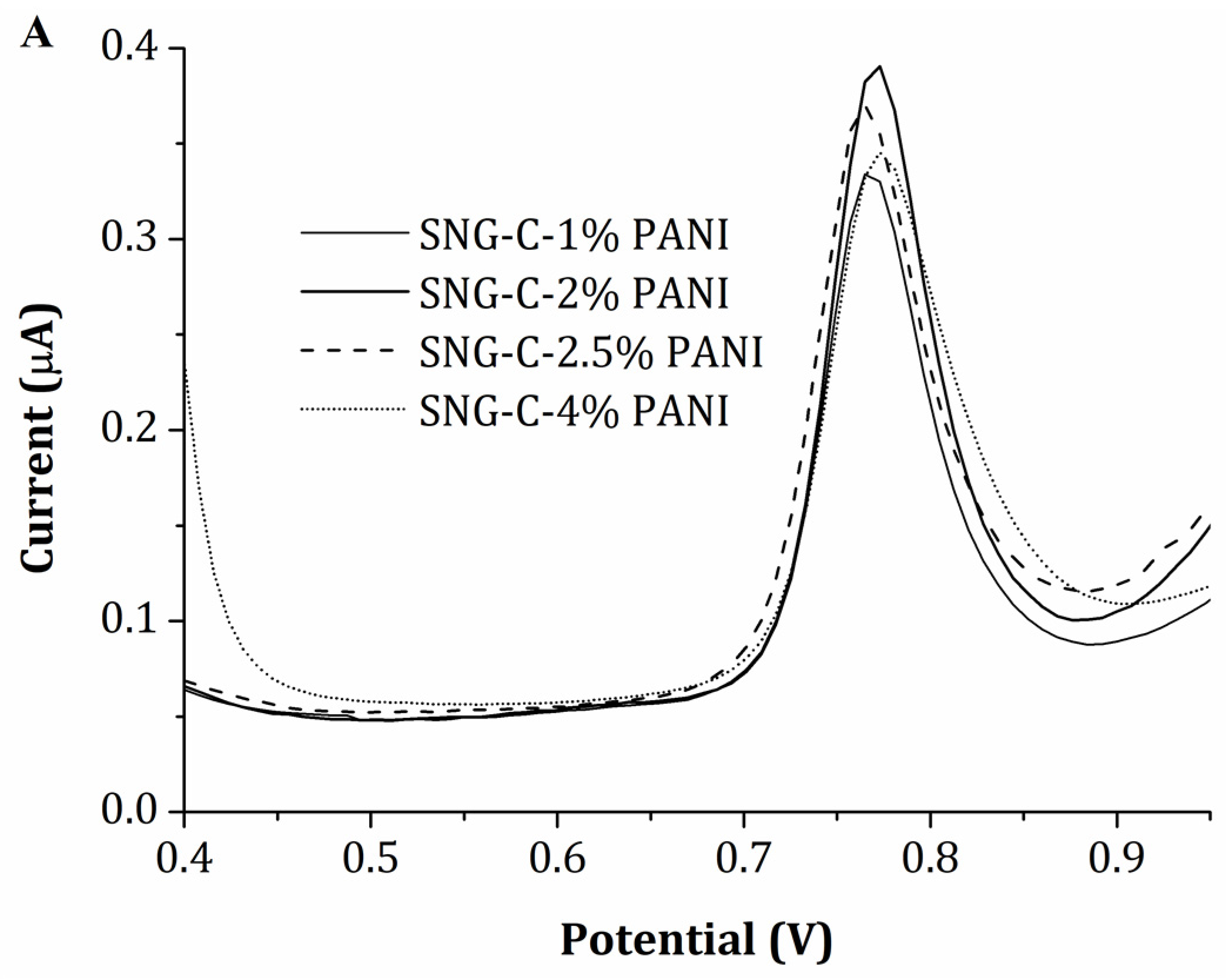

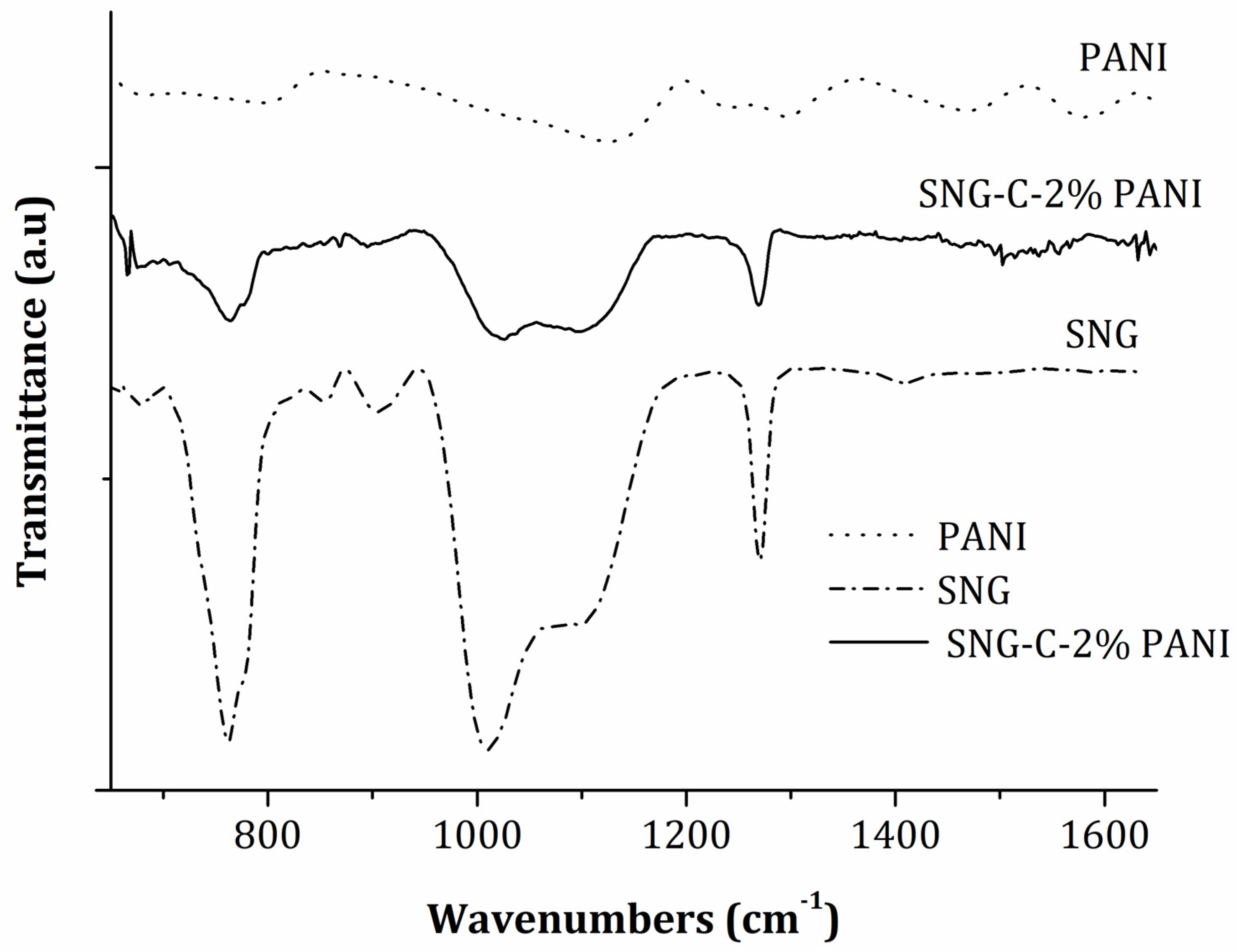

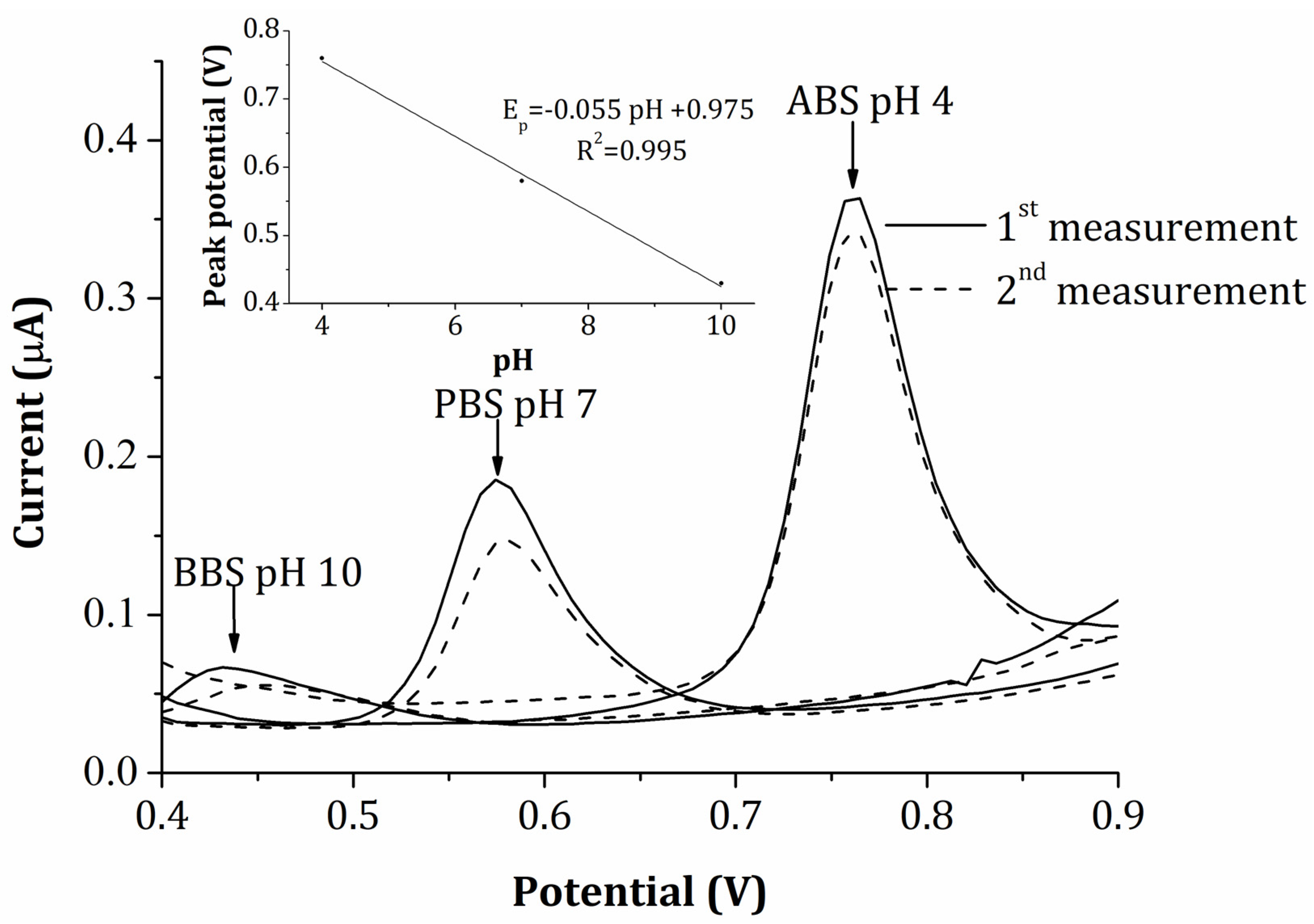
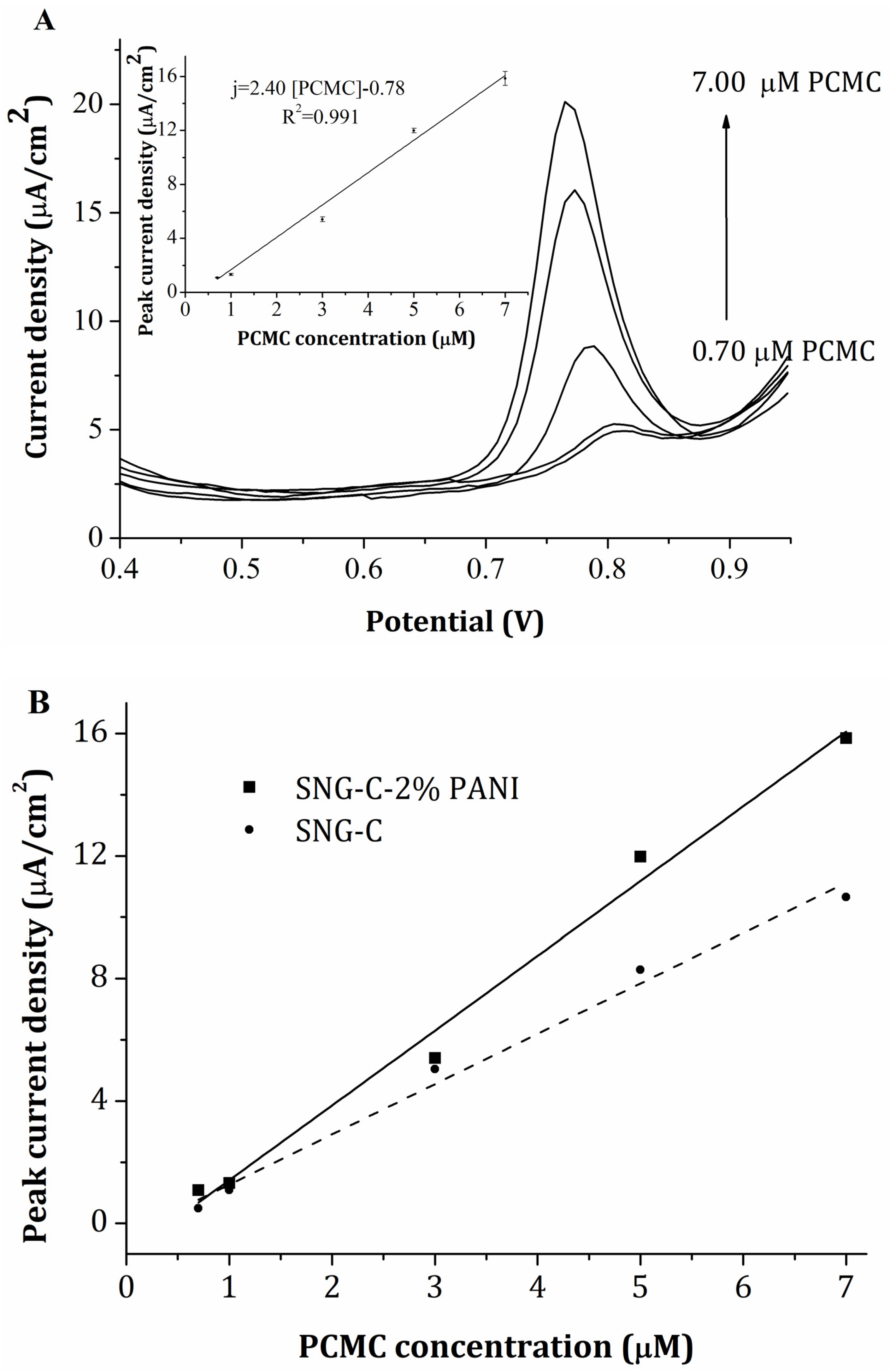

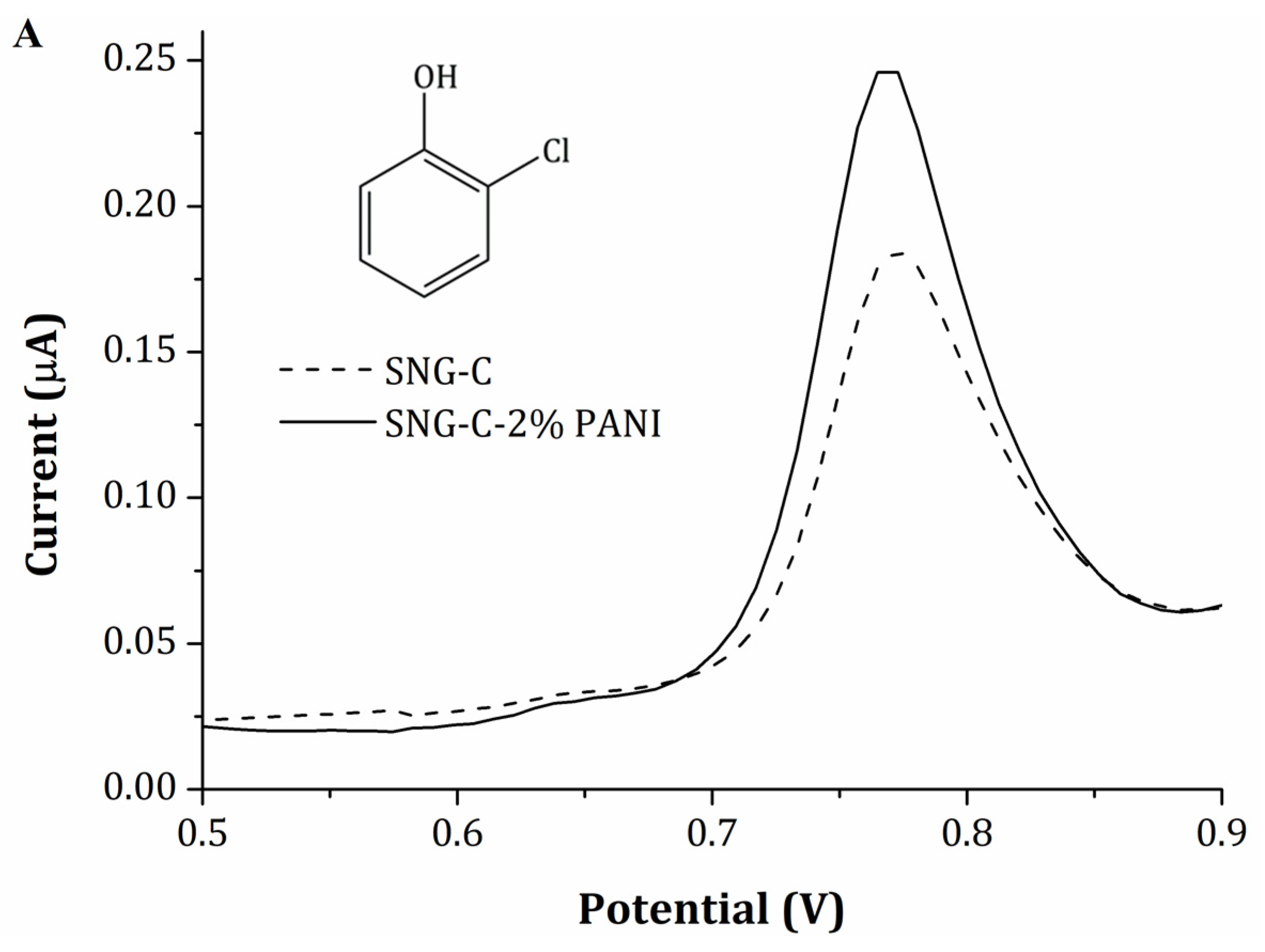

| Sensitivity [μA/μM·cm2] | LOD [μM] | Reference | |
|---|---|---|---|
| SNG–C–2% PANI | 2.40 | 0.69 | This work |
| MWCNT–GCE | 1.48 | 8.8 | [33] |
| GP–CCE | 0.28 | 2.71 | [26] |
| MWCNT–CCE | 1.41 | 0.71 | [26] |
| BDD | 0.08 | 0.46 | [34] |
| UiO-66-NH2@PEDOT/GA/GCE | 1.87 × 10−3 | 0.20 | [32] |
| Water from Diverse Sources | CAdded (μM) | CDetermined (μM) | Recovery (%) |
|---|---|---|---|
| Fountain water (Ubeda, Jaén) | 2.50 | 2.49 | 99.6 |
| Well water (Chiclana de la Frontera, Cádiz) | 2.50 | 2.32 | 92.3 |
| Tap water (Puerto Real, Cádiz) | 2.50 | 2.47 | 98.8 |
| Mineral water | 2.50 | 2.62 | 105 |
Disclaimer/Publisher’s Note: The statements, opinions and data contained in all publications are solely those of the individual author(s) and contributor(s) and not of MDPI and/or the editor(s). MDPI and/or the editor(s) disclaim responsibility for any injury to people or property resulting from any ideas, methods, instructions or products referred to in the content. |
© 2023 by the authors. Licensee MDPI, Basel, Switzerland. This article is an open access article distributed under the terms and conditions of the Creative Commons Attribution (CC BY) license (https://creativecommons.org/licenses/by/4.0/).
Share and Cite
Calatayud-Macías, P.; López-Iglesias, D.; Sierra-Padilla, A.; Cubillana-Aguilera, L.; Palacios-Santander, J.M.; García-Guzmán, J.J. Bulk Modification of Sonogel–Carbon with Polyaniline: A Suitable Redox Mediator for Chlorophenols Detection. Chemosensors 2023, 11, 63. https://doi.org/10.3390/chemosensors11010063
Calatayud-Macías P, López-Iglesias D, Sierra-Padilla A, Cubillana-Aguilera L, Palacios-Santander JM, García-Guzmán JJ. Bulk Modification of Sonogel–Carbon with Polyaniline: A Suitable Redox Mediator for Chlorophenols Detection. Chemosensors. 2023; 11(1):63. https://doi.org/10.3390/chemosensors11010063
Chicago/Turabian StyleCalatayud-Macías, Paloma, David López-Iglesias, Alfonso Sierra-Padilla, Laura Cubillana-Aguilera, José María Palacios-Santander, and Juan José García-Guzmán. 2023. "Bulk Modification of Sonogel–Carbon with Polyaniline: A Suitable Redox Mediator for Chlorophenols Detection" Chemosensors 11, no. 1: 63. https://doi.org/10.3390/chemosensors11010063
APA StyleCalatayud-Macías, P., López-Iglesias, D., Sierra-Padilla, A., Cubillana-Aguilera, L., Palacios-Santander, J. M., & García-Guzmán, J. J. (2023). Bulk Modification of Sonogel–Carbon with Polyaniline: A Suitable Redox Mediator for Chlorophenols Detection. Chemosensors, 11(1), 63. https://doi.org/10.3390/chemosensors11010063











